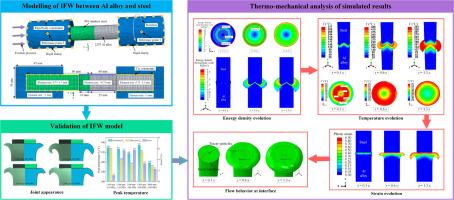Simulation of thermal-mechanical coupling in Al alloy/steel inertia friction welding
IF 7.1
1区 工程技术
Q1 ENGINEERING, MECHANICAL
International Journal of Mechanical Sciences
Pub Date : 2024-11-02
DOI:10.1016/j.ijmecsci.2024.109806
引用次数: 0
Abstract
Inertia friction welding (IFW) is a complicated thermal-mechanical coupling process. In-depth understanding of the thermal-mechanical process can improve the joint quality. In this study, a three-dimensional (3D) thermal-mechanical coupling model was successfully established to simulate the evolution of temperature, energy density, stress, strain, and flow behavior of the IFW process between 2219-O Al alloy and 304 stainless steel. The developed model was validated by comparing it with the measured temperature and deformation. Results show a transforming distribution of interface temperature from a M-shape to a squished V-shape during the IFW process. The characterization is attributed to the transformation of the accumulated friction energy density at the interface from a M-shape to an approximate V-shape due to the combined effect of varying sliding velocity and contact pressure. The Mises stress at the region near the interface is high and low at the steel and Al alloy sides, respectively. A significant portion of the kinetic energy stored in the flywheel is dissipated in the form of plastic deformation energy and cannot be neglected. The tracer particles show that most Al alloy at the initial interface is extruded to form flash, while a small amount of Al alloy is sticky and remains at the interface center. Increasing friction pressure and initial rotation speed result in higher interface temperature, axial shortening distance, and proportion of plastic work in total energy input.

铝合金/钢惯性摩擦焊接中的热机械耦合模拟
惯性摩擦焊(IFW)是一种复杂的热机械耦合工艺。深入了解热机械耦合过程可以提高接头质量。本研究成功建立了一个三维热机械耦合模型,用于模拟 2219-O Al 合金和 304 不锈钢之间的惯性摩擦焊过程中的温度、能量密度、应力、应变和流动行为的演变。通过与测量的温度和变形进行比较,对所建立的模型进行了验证。结果显示,在 IFW 过程中,界面温度分布从 M 型转变为挤压 V 型。这一特征可归因于在滑动速度和接触压力变化的共同作用下,界面上累积的摩擦能量密度从 M 型转变为近似 V 型。界面附近区域的米塞斯应力在钢侧和铝合金侧分别较高和较低。飞轮中存储的动能有很大一部分以塑性变形能的形式耗散,这一点不容忽视。示踪粒子显示,初始界面上的大部分铝合金被挤压形成闪蒸,而少量铝合金被粘住并留在界面中心。摩擦压力和初始转速的增加会导致界面温度、轴向缩短距离和塑性功在总能量输入中所占比例的增加。
本文章由计算机程序翻译,如有差异,请以英文原文为准。
求助全文
约1分钟内获得全文
求助全文
来源期刊

International Journal of Mechanical Sciences
工程技术-工程:机械
CiteScore
12.80
自引率
17.80%
发文量
769
审稿时长
19 days
期刊介绍:
The International Journal of Mechanical Sciences (IJMS) serves as a global platform for the publication and dissemination of original research that contributes to a deeper scientific understanding of the fundamental disciplines within mechanical, civil, and material engineering.
The primary focus of IJMS is to showcase innovative and ground-breaking work that utilizes analytical and computational modeling techniques, such as Finite Element Method (FEM), Boundary Element Method (BEM), and mesh-free methods, among others. These modeling methods are applied to diverse fields including rigid-body mechanics (e.g., dynamics, vibration, stability), structural mechanics, metal forming, advanced materials (e.g., metals, composites, cellular, smart) behavior and applications, impact mechanics, strain localization, and other nonlinear effects (e.g., large deflections, plasticity, fracture).
Additionally, IJMS covers the realms of fluid mechanics (both external and internal flows), tribology, thermodynamics, and materials processing. These subjects collectively form the core of the journal's content.
In summary, IJMS provides a prestigious platform for researchers to present their original contributions, shedding light on analytical and computational modeling methods in various areas of mechanical engineering, as well as exploring the behavior and application of advanced materials, fluid mechanics, thermodynamics, and materials processing.
 求助内容:
求助内容: 应助结果提醒方式:
应助结果提醒方式:


